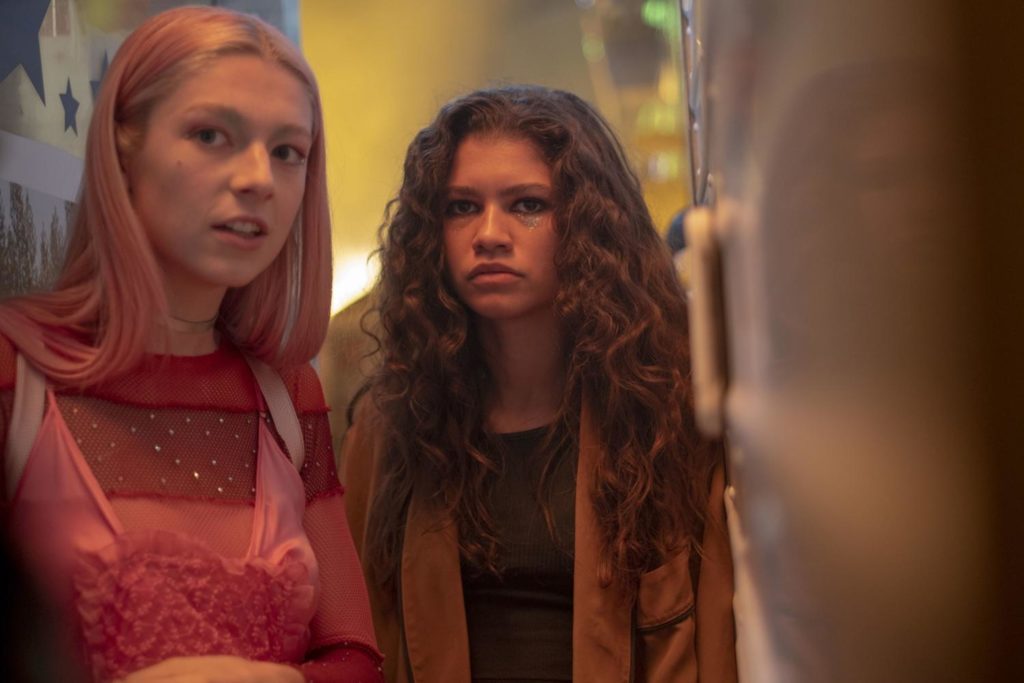Generation Z is often misunderstood by older generations due to generational differences and especially conservatism that clashes with a more ‘woke’ group of young people. It’s often hard to define us, and older generations struggle with putting labels on a society where being more free is encouraged. Like my mother and her love for Sixteen Candles and Fast Times at Ridgemont High, we too have staple movies and television shows that help represent our time period. Sam Levinison’s Euphoria—despite being an HBO show—is hard hitting, and its rustic plot draws so many audiences that it can be unofficially announced as Generation Z’s Ferris Bueler. Although Euphoria is most definitely a teen-targeted show with boyfriend drama (it’s also centered around high school), it brings up a lot of issues that are relevant in the world today. Besides the incredible cinematography and writing styles that the show has to offer, its intensive charm and character development is something that also makes this masterpiece worth watching.
Considering that the main plot is about a girl Rue who—after her father died—has been battling drug addiction, it is a difficult job for the cinematography to help represent that. Luckily enough, Levinson’s use of lights, cut shots, and blurred images help put into perspective what Rue is going through. The intelligence behind cutting between scenes of her fighting with her mom and her using is unheard of in a show that’s supposed to be more “mid.” When Rue is in her high, Euphoria features a show of lights, especially blues, that can represent her emotions fluctuating: red for anger, blue for sadness, and gold for final happiness. Another character, Nate Jacobs, is considered to be the high school’s “it-boy” with a whole side of psychopathic anger issues. Shots of him participating in drunk driving mixed with him walking down a hallway aid in showing the contrast between what he puts out there and what he actually feels. These creative choices really help put into perspective what’s really going on inside the heads of these characters. Unlike a book, a television show has to show what’s happening instead of just describing it with words, and Euphoria’s cinematography does an excellent job not just at looking cool, but with letting the audience really get to know our characters.
Arguably the most important reason to sit down and binge watch both seasons of an Emmy Award winning (congratulations Zendaya) show that features an award winning actress is that—unlike Riverdale, a gossipy, good for nothing show—the messages this show brings home are incredibly important in this day and age. In the last decade, a drug epidemic has started among teenagers all across the United States. Nicotine addiction and vaping is a real problem, and now most drugs are being laced with Fentanyl—which is deadly. More and more people are battling drug addiction, and to have a show that explains the highs and lows can almost aid in stopping people from getting involved with drugs in the first place. It gives people with drug addiction—although slightly dramaticized—a platform, and since it shows Rue’s darkest points, it actually turns people off as they see what happens to someone who’s addicted. Jules’ plotline, Rue’s love interest, is centered around her being a transwoman and her experiences with being different in society. Euphoria helps give so many different kinds of people representation, which a lot of teenagers need to see. The show also brings up more controversial issues such as drinking, sex, and even abortion. Daringly so, Levinson doesn’t shy away from facing these issues through a creative lense. Instead, he implements these issues on the outer level of the plotline so that people can get a glimpse of what it’s like to endure these different traumas.
Perhaps Euphoria’s biggest public draw-in is its ability to create interest and drama. The show itself is based off of a cheesy high school kind of vibe, and when you take away all of the other editing that’s done to make the show more sophisticated and serious, you realize that most people just like it for the drama it contains. Season 2 follows a rivalry between former friends Maddy Perez and Cassie Howard, and it does such a good job of making you want more and keeping you on your toes. There’s blackmail, secret love affairs, and fighting: things that people that watch Keeping Up With the Kardashians look for. These character plots contain all of the things that people who watch Friends, Saved By the Bell, and The Good Place love, and this secret formula will undoubtedly make you want to watch both seasons in one sitting. Psychologically, we love watching other people fight it out—as seen by those who watch MMA and UFC—and this show is perfect for satiating our wishes.
The greatest thing about Euphoria is that it can provide something for pretty much anyone who watches it. You like high school drama: great, both seasons are saturated with it. You want excellent cinematography: just watch the first five minutes and you’ll be floored. You want a show that brings up topics we should be talking about: the representation in this show is fantastic. Its audience is so widely diversified because it brings so many things to the table—no wonder it is an award winning show. Season 3 won’t be coming out for a while, so if you’re on the fence about it, it’s never too late to give it a shot.
